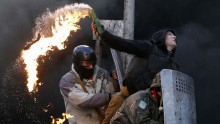World Press Photo 2015 is a competition of over 100,000 photos from 6,000 participants, photographers from 131 countries. Each year an independent international jury of professional photographers and photo editors from renowned worldwide media evaluates the contestants’ works in nine various categories, represented by photo journalists, agencies, newspapers, and magazines from all over the world.
Right at the entrance we come across the winning photo, made by Danish Mads Nissen, featuring a gay Russian couple (read an exclusive interview with the winner in The Day’s issue No. 35 of June 9). The general tone of the exhibit is rather tragic and mostly demonstrates the results of shocks and challenges humankind experiences nowadays: ecological disasters, Ebola, prostitution, kidnappings, war, and death. Foreign photographers also explore the tragic themes of Maidan, the war in the east of Ukraine, and the MH17 crash near Torez.
Curiously, this year for the first time in the contest of photo reportage the works of Ukrainian participants are presented in a separate exposition, “The Ukrainian Challenge.” Moreover, Ukraine is the first country to host the exhibit at the start of its worldwide tour, almost immediately after its presentation in the Netherlands, the organizer country.
“The Ukrainian Challenge” includes 24 works of Ukrainian photo journalists, who took part in World Press Photo competition, yet failed to win any prizes. The project is implemented in cooperation with NGO Camera Obscura, Viktor Marushchenko School of Photography, under the aegis of 1+1 Television News Service TSN and is sponsored by Canon, World Press Photo’s partner.
Erik de Kruijf, senior project manager of exhibitions, remarked that 2014 was a troubled year, and the works of the best masters reflect this tendency. “The humankind has again showed its dark, evil sides in many parts of the world: the endless civil war in Syria, the implacable cruelty of the Islamic State and Boko Haram, the long-lasting, bloody conflict in Ukraine: all the events that have stricken, and keep striking the world,” says de Kruijf. “In the year when Ukraine had to claim the central place in international news, Camera Obscura undertook the initiative to return World Press Photo exhibit to Kyiv. We are thankful for the brave choice, letting photography speak about past year’s events. No matter how graphic and moving the shots of Maidan battles or the wrecked plane are, they are a powerful reminder that war and violence can never be an answer.”
Says photographer Viktor MARUSHCHENKO, curator of “The Ukrainian Challenge”: “The events of the recent years have greatly promoted Ukrainian photo journalism both on the professional and civic plane. Clearly, our young photographers who have seen Euromaidan and ATO have changed. They have become seasoned professionals with a robust civil and human standpoint. Many are worthy of the highest awards for their excellent job, and some get such awards.”
In the framework of the project, on the website photo.tsn.ua, specially created for the occasion, anyone can vote for the best Ukrainian photo which took part in World Press Photo 2015 contest. The voting began on June 9. Three winners will receive valuable prizes from Canon and EastPack at the awarding ceremony on June 30. The first prize of “The Ukrainian Challenge” is the camera Canon EOS M3.
“I am just crushed by the exposition, these shots are striking. There hangs a feeling of Ukrainians being underestimated as a nation by the people living in another civilization,” said Natalia Moseichuk, TSN anchor at 1+1, in her comment to The Day. “It is disappointing that Ukrainian photographers have not won. However, the dramatic events from the ATO zone and Euromaidan were awarded in three nominations at once. It seems to me that Ukrainian photographers have been left without prizes because people in the West do not quite understand what is going on in the east of this country. I am perfectly aware that Ebola is important and it is horrible; that drowning refugees from Africa landing in Italy are a great problem; that protests in Turkey and brutal beating of protesters are worth being filmed and shown to the public. But when the fate of every individual and of the entire country hangs in the balance – well, I think it is worth speaking of, and it deserves a proper appraisal. Sadly enough, it was not appraised because Ukrainian journalists have not won any awards in this contest. But maybe the value of this exhibit is in its ability to reveal itself later, when some things are already forgotten, when the world (and us) begins to live a better life, when everything will be alright in this country. And then we will remember who we owe all this to, and what we have been through.”
The exhibit will last through June 30.








